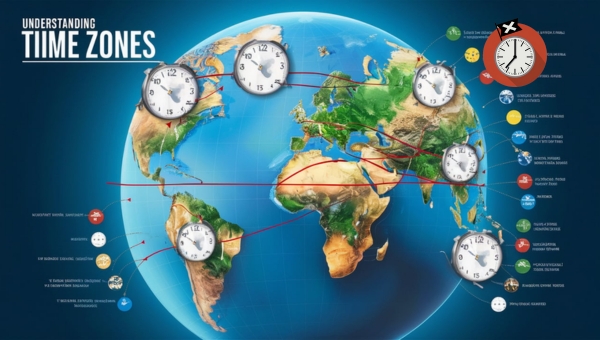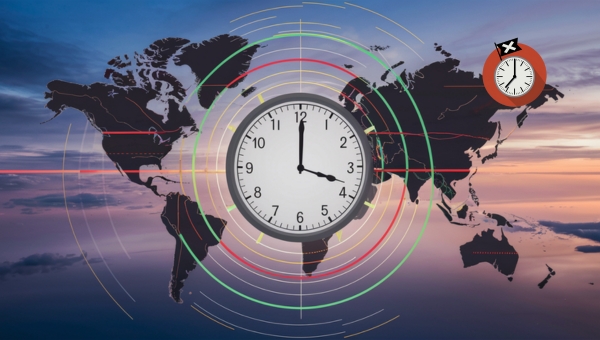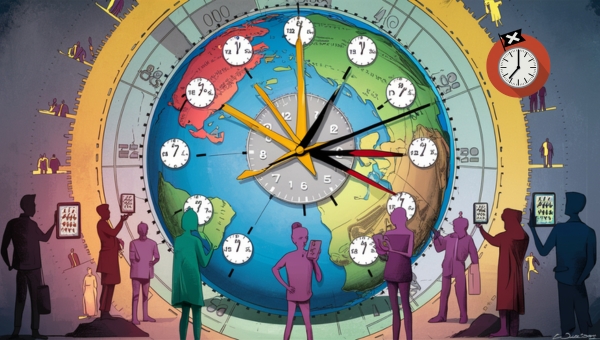Time Zones Explained: From UTC to Daylight Saving Time

Understanding time zones can seem tricky, but it’s crucial for global communication and travel. In this article, we’ll delve into the basics of time zones, explaining everything from Coordinated Universal Time (UTC) to the quirks of Daylight Saving Time (DST).
We’ll explore how time zones are structured, why they matter for international interactions, and the various challenges they present. By the end, you’ll have a comprehensive understanding that will make navigating time differences a breeze.
Understanding Time Zones
Time zones are an essential part of our daily lives, governing how we schedule our activities, communicate across distances, and manage global operations. They are geographic regions where the same standard time is used.

The concept of time zones helps us manage the differences in local times across various parts of the world, ensuring a synchronized and organized approach to timekeeping.
Coordinated Universal Time (UTC)
Coordinated Universal Time (UTC) serves as the primary reference point for all time zones worldwide. It is the standard by which the world regulates clocks and time.
UTC is maintained using highly accurate atomic clocks and is not affected by seasonal changes.
- Definition: UTC is the time standard used across the globe, based on the time at the Prime Meridian (0° longitude) in Greenwich, England.
- Global Timekeeping: It provides a uniform time reference, ensuring consistency in timekeeping regardless of geographic location.
- Atomic Clocks: UTC relies on atomic clocks for its accuracy, making it precise to fractions of a second.
Daylight Saving Time (DST)
Daylight Saving Time (DST) is a practice where clocks are set forward by one hour during the warmer months to extend evening daylight.
This shift aims to make better use of daylight during the longer days of spring, summer, and early autumn.
- Purpose: DST is intended to save energy, reduce the need for artificial lighting, and make better use of natural daylight.
- Regional Impact: Different regions may observe DST differently, and some may not observe it at all. This can lead to variations in timekeeping.
- Time Change: Typically, clocks are set forward by one hour in the spring (“spring forward”) and set back by one hour in the autumn (“fall back”).
Time Zone Offsets
Time zone offsets indicate how much a region’s time differs from UTC. These offsets are crucial for determining local time in different parts of the world.
- Offset Calculation: Time zones are typically expressed as UTC plus or minus a number of hours (e.g., UTC+2 or UTC-5).
- Geographical Variations: The offset can vary based on a region’s longitude, as well as its adherence to DST.
- Local Customs: Some areas may have unique offsets due to historical, political, or cultural reasons.
Understanding time zones is fundamental for global coordination and communication. Whether it’s setting up a meeting with someone halfway across the world, planning travel, or simply adjusting to seasonal time changes, time zones play a vital role in our interconnected world.
Structure of Time Zones
Understanding the structure of time zones is crucial for grasping how our global society keeps time. From the universal standard of Coordinated Universal Time (UTC) to the intricacies of Daylight Saving Time (DST) and local time zone offsets, each component plays a vital role in maintaining order in our daily lives. Let’s dive into the details of these elements.

Coordinated Universal Time (UTC)
Coordinated Universal Time, commonly abbreviated as UTC, serves as the primary reference point for timekeeping around the globe. It is the successor to Greenwich Mean Time (GMT) and is maintained by a network of atomic clocks worldwide.
- Definition: UTC is the standard by which the world regulates clocks and time. It is not adjusted for daylight saving time, making it a consistent reference all year round.
- Accuracy: The precision of UTC comes from atomic clocks, which are incredibly accurate and only lose a second in millions of years.
- Global Use: All local time zones are defined by their offset from UTC. For instance, New York operates on UTC-5 during standard time and UTC-4 during daylight saving time.
UTC is the cornerstone of global timekeeping, ensuring that everyone from air traffic controllers to international businesses operates on a common time framework.
Daylight Saving Time (DST)
Daylight Saving Time (DST) is a practice used by some regions to make better use of daylight during the longer days of summer.
- Purpose: The main goal of DST is to conserve energy by reducing the need for artificial lighting in the evening hours.
- Implementation: Clocks are set forward by one hour in the spring (“spring forward”) and set back by one hour in the fall (“fall back”).
- Regional Differences: Not all countries or regions observe DST. For example, most of the United States and Europe practice DST, while many countries near the equator do not, due to minimal variation in daylight throughout the year.
The impact of DST on time zones can be significant, affecting everything from travel schedules to international business meetings.
Time Zone Offsets
Time zone offsets are the differences in hours and minutes from Coordinated Universal Time (UTC) that define local times across the globe.
- Definition: A time zone offset indicates how much a particular region’s time differs from UTC. For example, Central European Time (CET) has an offset of UTC+1.
- Geographical Variations: Time zone offsets can vary widely due to geographical location. Countries that span large areas, like Russia and the United States, have multiple time zones.
- Local Customs: Some regions have unique offsets that are not whole hours. For example, India operates on UTC+5:30, and Nepal on UTC+5:45.
Understanding these offsets is essential for accurate global communication, travel planning, and synchronization of activities across different regions.
Importance of Time Zones
Time zones play a crucial role in our daily lives, impacting everything from communication to travel and business operations. Understanding the importance of time zones can help streamline global interactions and foster better coordination. Let’s delve into how time zones influence various aspects of our lives.

Global Communication and Travel
Time zones are essential in facilitating smooth global communication, travel, and business operations. Here’s how:
- Communication: With different parts of the world operating in various time zones, knowing these differences ensures timely and effective communication. For instance, scheduling a virtual meeting between teams in New York and Tokyo requires awareness of the significant time difference.
- Travel: For travelers, understanding time zones helps them manage jet lag and plan itineraries. When flying from Los Angeles to London, travelers need to adjust their watches and bodies to a new time zone, which can impact their travel experience.
- Business Operations: In the business world, time zones influence trading hours, customer support availability, and project deadlines. Companies operating globally rely on time zone knowledge to coordinate with international clients and partners efficiently.
International Agreements
Standardizing time zones globally is a complex task managed through various international agreements and organizations.
Here’s an overview:
- International Meridian Conference: Held in 1884, this conference established the Prime Meridian at Greenwich, setting the foundation for modern time zones. This agreement helped create a standardized system that countries could adopt.
- International Telecommunication Union (ITU): This organization plays a role in coordinating global time standards, and ensuring consistency in timekeeping practices across countries.
- Coordinated Universal Time (UTC): UTC serves as the primary time standard by which the world regulates clocks and time. It is maintained by a series of atomic clocks worldwide, providing a precise and uniform time reference.
By understanding and adhering to these agreements, countries can ensure seamless synchronization of time, which is vital for international cooperation and efficiency.
Time zones may seem like a simple concept, but their impact on our interconnected world is profound. From enabling effective communication to supporting global business operations and maintaining standardized timekeeping, time zones are an essential part of our daily lives.
Time Zones Around the World
Time zones play a crucial role in keeping our world organized, especially as we navigate global communication and travel. Understanding the major and unusual time zones will illuminate how they impact our daily lives and global operations.
Major Time Zones
When discussing major time zones, several prominent examples come to mind:
- Greenwich Mean Time (GMT): Serving as the starting point for time zone calculations, GMT is the baseline from which all other time zones are measured. It is centered on the Prime Meridian in Greenwich, London.
- Eastern Standard Time (EST): This time zone is used in the eastern part of the United States and Canada. It is five hours behind GMT and plays a significant role in the business and media industries.
- Central European Time (CET): CET is one hour ahead of GMT and is widely used across Europe, including countries like France, Germany, and Italy. It helps synchronize activities across the continent.
- China Standard Time (CST): Although China spans five geographical time zones, the entire country uses CST, which is eight hours ahead of GMT. This unification simplifies scheduling within the country.
Unusual Time Zones
While most time zones follow a standard hourly offset from GMT, some regions adopt unique time adjustments that set them apart:
- India Standard Time (IST): IST is five and a half hours ahead of GMT, making it a half-hour time zone. This unique offset helps align the time more closely with the country’s natural daylight hours.
- Newfoundland Standard Time (NST): NST is another example of a half-hour time zone, being three and a half hours behind GMT. This time zone is specific to the island of Newfoundland in Canada.
- Nepal Time (NPT): Even more unusual, Nepal Time is five hours and forty-five minutes ahead of GMT. This 15-minute increment sets Nepal apart from neighboring countries.
- Australian Central Standard Time (ACST): ACST is nine and a half hours ahead of GMT and is used in parts of Australia, such as South Australia and the Northern Territory.
These distinctive time zones highlight the diversity and complexity of global timekeeping, ensuring that local customs and daylight patterns are respected.
Challenges and Controversies
Time zones present various challenges and controversies that impact daily life, business operations, and global communication. Understanding these issues is crucial for navigating the complexities of timekeeping across the world. Let’s delve deeper into two prominent aspects: time zone confusion and Daylight Saving Time debates.
Time Zone Confusion
Time zone confusion is a common issue, especially when traveling or coordinating activities across countries.
Here are some key points to consider:
- Traveling Across Time Zones: When crossing multiple time zones, travelers often face jet lag, which disrupts their sleep patterns and overall health. This adjustment can be particularly challenging for frequent flyers.
- Scheduling Meetings: Coordinating meetings across different time zones can be tricky. For instance, a meeting scheduled at 3 PM in New York may be at 12 PM in Los Angeles, causing potential misunderstandings and missed appointments.
- Digital Device Settings: Many digital devices automatically adjust to local time zones. However, discrepancies can occur if devices are not updated or if users travel to regions with unusual time zones, leading to missed alerts or reminders.
Daylight Saving Time Debates
Daylight Saving Time (DST) is another contentious topic, with debates surrounding its benefits and drawbacks.
Here are some points to explore:
- Purpose of DST: Initially introduced to make better use of daylight during the longer days of summer, DST aims to save energy by reducing the need for artificial lighting in the evening. However, its effectiveness is widely debated.
- Health Impacts: Changing the clocks twice a year can disrupt sleep patterns and negatively affect mental and physical health. Some studies suggest a link between DST transitions and increased risks of heart attacks and other health issues.
- Economic and Social Considerations: Supporters argue that DST boosts the economy by encouraging outdoor activities and shopping in the evening. Conversely, critics claim that the energy savings are minimal and that the costs of adjusting clocks and schedules outweigh the benefits.
- Movements to Abolish DST: Various regions and countries are considering or have already abolished DST. For instance, the European Union has discussed ending the practice, allowing member states to choose between permanent standard time or permanent DST.
Understanding these challenges and controversies is essential for effectively managing time in our interconnected world. By addressing these issues, we can improve communication, health, and efficiency across different time zones.
Conclusion
Understanding time zones is vital for our interconnected world. From Coordinated Universal Time (UTC) to Daylight Saving Time (DST), these systems ensure synchronized global communication, travel, and business operations.
Time zone offsets and international agreements further streamline our daily activities. While some regions have unique time zones, the challenges and controversies, such as time zone confusion and DST debates, continue to spark discussions.
By grasping these basics, you can better navigate the complexities of global timekeeping. If you found this blog helpful, be sure to explore more insightful articles on our site!





